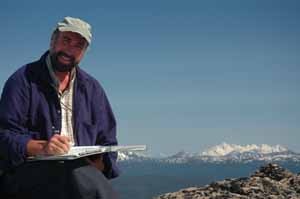Segmentation of the Western Laurentian Continental Margin: Evidence for Active Tectonism in the Neoproterozoic-Cambrian ‘Miogeocline’
Dr. Brian J. Mahoney
Professor, University of Wisconsin-Eau Claire
Thursday, October 8th, 2015
CSL 422 – 9:30am
Abstract
Major variations in Neoproterozoic to Cambrian stratigraphy along the western Laurentian continental margin require along-strike structural inhomogeneties during Neoproterozoic extension. Thick miogeoclinal Neoproterozoic and Cambrian strata in southern Idaho and Utah are abruptly truncated along the present Snake River Plain and do not extend into central Idaho and Montana. Similarly, coeval miogeoclinal strata in British Columbia do not extend south into Idaho and Montana. Neoproterozoic to Cambrian stratigraphic and structural relationships in western Montana and central Idaho require the continental margin was tectonically active.
Sparse Neoproterozoic to Cambrian strata of central Idaho and Montana suggest deposition on an irregular topographic surface. North of the Helena Salient of the Montana fold and thrust belt, near Lewis and Clark Pass, the Flathead Sandstone unconformably overlies both the Ravalli (lower Belt) and Missoula (upper Belt) groups, which requires substantial pre-middle Cambrian uplift (>5 km) and erosion of the Belt Supergroup. South of the Helena Salient, near Ermont, MT, boulder fanglomerate within the Flathead Sandstone where it unconformably overlies probable pre-Belt “Argenta” strata suggests structurally-controlled sedimentation. In central Idaho, where Cambrian strata are absent, rapid uplift and erosion of Neoproterozoic alkalic plutons yields 500 Ma zircon within the ca. 500 Ma Worm Creek quartzite of SE Idaho.
In contrast, within the Helena Salient, area, the contact between coarse-grained Flathead Sandstone and underlying fine-grained strata mapped as the Mesoproterozoic Belt Supergroup (Ravalli Group) in fact appears to be a conformable transition. This relationship suggests rocks mapped as Belt Supergroup in Montana may in part actually represent Neoproterozoic to Middle Cambrian strata conformably below the Flathead Sandstone. This interpretation is supported by the intercalation of two distinct zircon populations and by the recent discovery of low diversity ichnofauna in this succession.
The highly variable nature of the basal Cambrian contact (locally an angular unconformity, a disconformity above crystalline basement, and an apparent conformable contract), the coarse grained nature of basal Cambrian strata, evidence for uplift of both Belt Supergroup strata (>5 km) and the existence of rapidly exhumed Neoproterozoic plutonic rocks suggests the continental margin was tectonically active in Neoproterozoic to Cambrian time. These structural and stratigraphic relationships suggest the northern Rocky Mountains north of the modern Snake River Plain acted as an independent structural domain distinct from subsiding areas to the south and north during Neoproterozoic rifting, and was characterized by episodic uplift, intermittent sedimentation and sporadic magmatism. These features are quite distinct from the classic miogeoclinal successions in southern Alberta and British Columbia and southern Idaho and Utah. This geometry is consistent with the asymmetric extension of the continental margin postulated by Lund et al (2010).
 B. J. Mahoney, Segmentation of the Western Laurentian Continental Margin: Evidence for Active Tectonism in the Neoproterozoic-Cambrian ‘Miogeocline’, GSA Session No. 341, 4 November 2015
B. J. Mahoney, Segmentation of the Western Laurentian Continental Margin: Evidence for Active Tectonism in the Neoproterozoic-Cambrian ‘Miogeocline’, GSA Session No. 341, 4 November 2015


